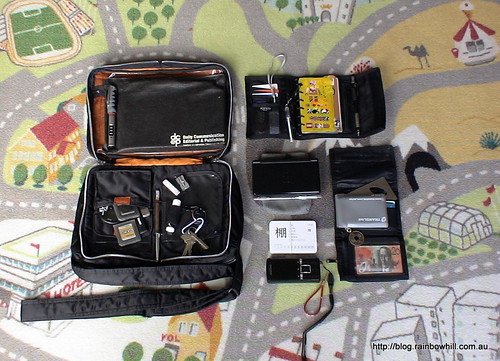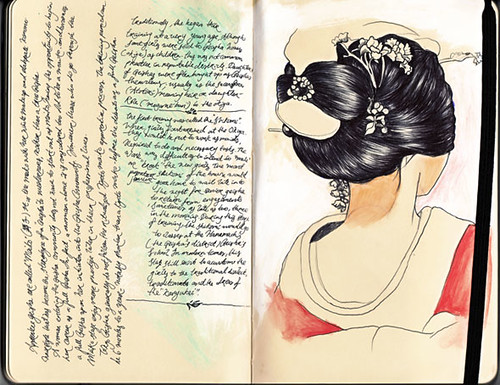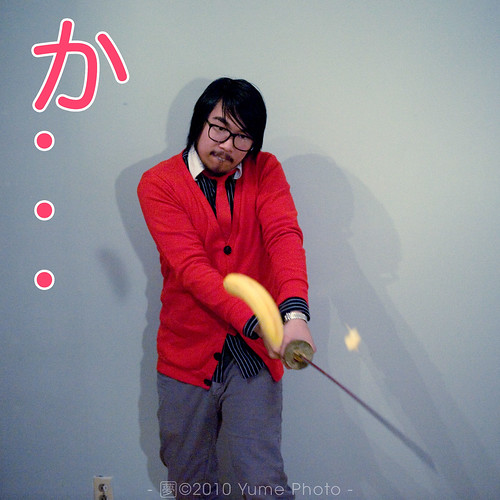No secret, you need to have a decent vocabulary if you want to be proficient in in Japanese. Despite all the hype about the latest iPhone apps and Spaced Repetition Systems, using Kanji Flashcards is still one of the best ways to memorise large amounts of vocabulary. I'll show you how.
 Mr. & Mrs. Pump by David Clow - Maryland
Mr. & Mrs. Pump by David Clow - Maryland The systematic use of Kanji Flashcards is based on the premise that repetition of word-item pairs at regular intervals improves memory retention. Sure, Spaced Repetition Systems like smart.fm take the hard work out of organising your repetitions for you, but they shouldn't be the only tool you use.
I've recently been increasing my work-rate on smart.fm because it's fast and progress is measured, yet I still carry my White Rabbit Press Kanji Flashcards with me everywhere I go. Let me explain why.
Like most 30 something city dwellers, I carry too many gadgets. There's my cell phone, my Nintendo DS, my mp3 player sometimes an extra camera or my notebook. Leaving the house without them has a liberating effect. When I am in study-mode I can't leave the house without my kanji cards.
Kanji Flashcards help you focus on the task at hand and unlike cell phones they won't interrupt you. They work even when you are out of a mobile service area.
How to make flashcards work for you.
Having a set of flashcards isn't going to give you jedi skills automatically, you have to put the cards in to use. Here some quick tips you can use right now.
- Be consistent: Just as with any study technique to see results you need to be consistent over time. Regular use of Kanji Flashcards should be a part of your daily routine. Your daily routine needs to include a variety of study activities, like reading for pleasure. Carry your Kanji Flashcards with you everywhere you go, and pull them out in the in-between moments you create for yourself thoughout the day.
- Manage your repetitions systematically: Spaced Repetition Systems work so well because they use an algorithm that schedules the repetition of learned material just when you might be about to forget it. The algorithms are constantly being refined, but they were first used over a hundred years ago by obscure European scientists. You don't need to be an eccentric genius however to implement your own system. I recently described how set up my own analogue Spaced Repetition System with a Leitner box.
- Introduce new material gradually: To avoid burnout make sure you don't put too much pressure on yourself early on. Five new items a day is a good rule of thumb, you may want to increase this to ten or twelve once you have some momentum, but any more is counter productive.
- Use a deck that suits your learning goals: The first 900 odd cards I used came from Tuttle, and they've been good for me, to a point. Looking more closely at them now I realise perhaps they weren't the best choice for my learning goals. I'll go into more detail in a moment.
The enemies of any study routine.
- Apathy, and laziness: No matter what study tools you have at your disposal, they all amount to nothing if you don't use them to craft yourself a new language. Get to work!
- Disorganisation: Don't know what to do next? Constant switching between study modes could be stopping you from developing the focus and discipline you need to master Japanese. Get a plan!
- Bad habits: Get into the habit of success. Getting into good habits takes time, and it's not something that happens the moment you decide to change your behaviour. Along with your commitment to modifying your behaviour comes a constant effort to stay on track.
- Interruption: Learn to identify the critical and eliminate the trivial. Easier said than done, but I'm becoming a master in the art of polite refusal and cultivating the "don't mess with me, I'm studying" mask.
In a nutshell.
To make your flashcards work for you, be disciplined and use a system for organising your repetitions. Carry them everywhere you go. Gradually increase the rate at which you are introducing new material.How do the White Rabbit Press cards stack up against the others?
As I mentioned before I've known two sets of cards. My first two boxes were Tuttle Kanji Cards. Now I carry both and I'm happy to endorse White Rabbit Press Kanji Flashcards over Tuttle for a whole number of reasons.The presentation and finish of the WRP Kanji Flashcards is excellent. The cards won't go yellow as quickly because of their varnished surface. This, and the rounded corners make it easier to hold them and flip between them. At first I was clumsy with them because of the landscape orientation but I'm steadily becoming accustomed to them.

Each card has six word/phrase items compared to the four on the Tuttle cards. Each item is complete as an example of usage, rather than an abstract pattern. The front of the cards have fewer distractions on them, as there are no references to common dictionaries or kanji grade on the front of the card. The are examples of look alike kanji, something that is important if you are studying for a test that contains lots of multiple choice questions with similar looking kanji (hint hint).
If you are studying Japanese over at textfugu, then you'll know how much of an emphasis Koichi puts on learning radicals. The White Rabbit Press Kanji Flash Cards clearly identify the radical on the face of the card. The focus is clearly on the structure and use of the kanji, not the clutter.
On the back of the cards each kun and on reading is written in kana, all the Japanese is in Japanese, which makes a lot more sense. Everyone knows that romaji is a crutch. This is by far and away the most important point for me in preparation for the JLPT this year. Reading Japanese on the front and the back of the card means that I don't have to make the cognitive leap from Japanese to English and and back again each time I flip the cards over. For this point alone you should buy the WRP Kanji Flashcards.
There are other benefits to these cards, including the extensive support and documentation available at the White Rabbit Press site.
Visit White Rabbit Press to get more to get more details, including information about which cards you'll need for the New JLPT.
My disclosure and a confession to make.
Joseph Tame from White Rabbit Press generously offered me Volume 3 of the Kanji Flashcards to test drive in January. I would have paid for them but they came just at the right time as I was at the point of making a decision to continue with the Tuttle cards I'd been using up until then. I'm glad I made the switch.Joseph interviewed me a while ago on the Japan Podshow, long before he became involved with White Rabbit Press.
The biggest confession I have to make is that I've been sitting on these for so long. First, I wanted to consolidate my knowledge of the first 1000 kanji, which I did with the Tuttle Cards. Second, I didn't feel I could endorse them as well as I do know with out using them consistently for a few months. I've been meaning to review them for ages.
You'll notice that I'm rather particular about the things that I recommend on my blog, now just seems to be like the right time. I don't have the first two boxes, though I probably should put in an order just to round out my set.
Do you use Kanji Flashcards? Which ones? Do they work for you?
Thanks for making this blog such great place to learn about Japanese language and culture. Thank you for the 'like' on Facebook.
If you want to find out more about the cards from people that are using them check out the White Rabbit Press fan page on Facebook. They are also on Twitter too (@WhiteRabbitJpn).








